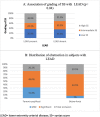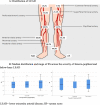Association of severity of coronary artery disease by SYNTAX score (SS) and lower extremity arterial disease by duplex ultrasound (DUS) study-an Indian perspective
- PMID: 32894377
- PMCID: PMC7477019
- DOI: 10.1186/s43044-020-00091-z
Association of severity of coronary artery disease by SYNTAX score (SS) and lower extremity arterial disease by duplex ultrasound (DUS) study-an Indian perspective
Retraction in
-
Retraction Note: Association of severity of coronary artery disease by SYNTAX score (SS) and lower extremity arterial disease by duplex ultrasound (DUS) study-an Indian perspective.Egypt Heart J. 2020 Dec 29;72(1):89. doi: 10.1186/s43044-020-00130-9. Egypt Heart J. 2020. PMID: 33373010 Free PMC article. No abstract available.
Abstract
Background: Coronary artery disease (CAD) and lower extremity artery disease (LEAD) often coexist. Ankle brachial index (ABI) has been shown to be an independent predictor of CAD. Studies have reported correlation of CAD and LEAD on the basis of ABI and also invasive angiography. But rigorous searching did not reveal any similar research where severity of LEAD was assessed by duplex ultrasound (DUS). In this study, we assessed the association of severity and localisation of LEAD by DUS with SYNTAX score (SS).
Results: A total of 637 subjects above 45 years of age with coronary angiographic confirmation of CAD were studied in this single centre cross-sectional, descriptive and analytical research. High SS was significantly more common in subjects with LEAD (p = 0.04). In the femoro-popliteal segment, total occlusion of arteries was found in significantly more proportion of subjects with high SS. A progressive increase in mean SS was noted across the grades of arterial disease in the femoro-popliteal segment (p = 0.007). 85.2% of the LEAD was in the femoro-popliteal segment, while below-knee arterial disease was present in 98.5% of subjects with LEAD. Hypertension, smoking, history of CVE and presentation with ACS independently increased the risk of LEAD.
Conclusion: High prevalence of asymptomatic LEAD and association of high SS with LEAD as a whole as well as femoro-popliteal involvement suggests the need for a point of care DUS study (POCUS) since treatment varies with location and extent of disease which cannot be fathomed by ABI alone. Being the largest study on association of CAD and LEAD from Indian subcontinent till date and also the first study to use non-invasive tool as DUS for LEAD assessment while studying its association with CAD makes this a landmark experience.
Conflict of interest statement
The authors declare that they have no competing interests.
Figures


Similar articles
-
Retraction Note: Association of severity of coronary artery disease by SYNTAX score (SS) and lower extremity arterial disease by duplex ultrasound (DUS) study-an Indian perspective.Egypt Heart J. 2020 Dec 29;72(1):89. doi: 10.1186/s43044-020-00130-9. Egypt Heart J. 2020. PMID: 33373010 Free PMC article. No abstract available.
-
Duplex ultrasound of the superficial femoral artery is a better screening tool than ankle-brachial index to identify at risk patients with lower extremity atherosclerosis.J Vasc Surg. 2008 Apr;47(4):789-92; discussion 792-3. doi: 10.1016/j.jvs.2007.11.023. Epub 2008 Feb 14. J Vasc Surg. 2008. PMID: 18280098
-
Prediction of coronary artery disease severity in lower extremity artery disease patients: A correlation study of TASC II classification, Syntax and Syntax II scores.Cardiol J. 2017;24(5):495-501. doi: 10.5603/CJ.a2017.0033. Epub 2017 Mar 29. Cardiol J. 2017. PMID: 28353312
-
Retrograde Popliteal Access and Balloon Dilatation of Chronic Total Occlusion of Superficial Femoral Arteries.Ann Vasc Surg. 2020 Apr;64:253-262. doi: 10.1016/j.avsg.2019.09.030. Epub 2019 Oct 18. Ann Vasc Surg. 2020. PMID: 31634601
-
Popliteal artery aneurysms. Factors associated with thromboembolism and graft failure.Int Angiol. 2004 Mar;23(1):54-65. Int Angiol. 2004. PMID: 15156131 Review.
Cited by
-
Retraction Note: Association of severity of coronary artery disease by SYNTAX score (SS) and lower extremity arterial disease by duplex ultrasound (DUS) study-an Indian perspective.Egypt Heart J. 2020 Dec 29;72(1):89. doi: 10.1186/s43044-020-00130-9. Egypt Heart J. 2020. PMID: 33373010 Free PMC article. No abstract available.
References
-
- Pellegrino T, Storto G, Filardi PP, et al. Relationship betweenbrachial artery flow-mediated dilation and coronary flow reserve in patients with peripheral artery disease. J Nucl Med. 2005;46(12):1997–2002. - PubMed
Publication types
LinkOut - more resources
Full Text Sources
Miscellaneous
